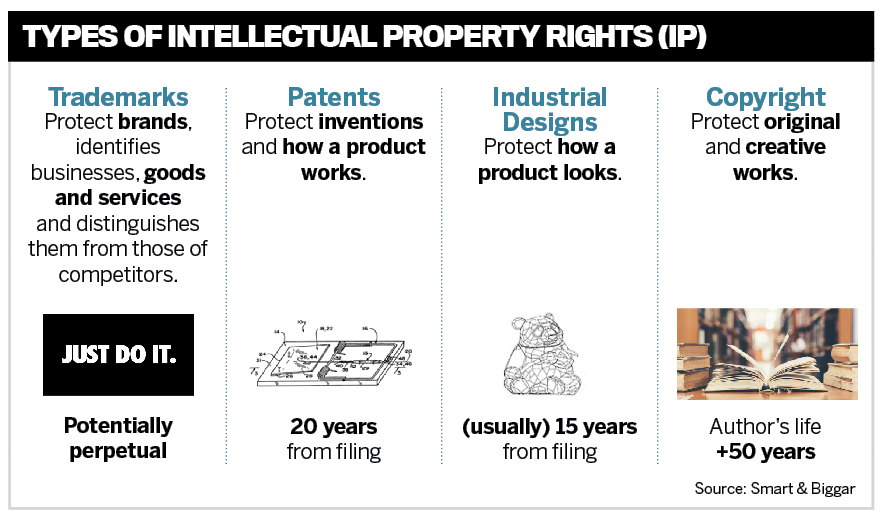IP lawyers say SMEs should focus on intangible assets from the start

Most entrepreneurs and small and medium business owners understand that their intellectual property — those intangible assets such as ideas, content, brands, reputation, designs, confidential information — is valuable. However, businesses often don’t realize how important it is to protect this IP through securing rights to ensure the smooth running of their business.
“Almost every small business undervalues its intangible assets,” says Brigide Mattar, partner and patent agent at Smart & Biggar in Montreal. While they understand that what they have or do is unique, “often, they only worry about IP when something goes wrong.”
Typically, “and this is the sad part,” Mattar says, “you’ll have a company that is small and not hitting the radar yet — and then they start commercializing and getting bigger.” Once that happens, the more prominent, established players who have IP assets start to get bothered by the upstart, and some, especially those in the U.S., “tend to be a lot more aggressive.”
And that’s when the small or medium business or entrepreneur gets the “cease and desist” letter, and they now “have to react rather than having been proactive on their IP in the first place.” It often takes this kind of wake-up call for SMEs to realize that they should have started on the road to protecting their IP a lot earlier in their business development, Mattar says.

Brigide Mattar
A significant portion of the business value of early-stage companies relates to IP and intangibles, she says, adding that “when properly used, IP rights can unlock value from these intangibles.”
It’s not necessarily a case of having to do everything at once, Mattar says. Yet IP can help drive revenues and support the business with a strategy that includes IP rights protection, whether it is trademark, patents, copyright or trade secrets.
Having a solid IP strategy in place can also become very important when looking for financing or selling the company, Mattar says, because one of the first things a savvy investor or buyer is looking for risk, including IP risk.
Trent Horne, a partner with Aird & Berlis LLP, adds that pretty much all SMEs “own intellectual property whether they know it or not.”
However, the challenge is that “not all business owners have a clear understanding of what IP is, or even know what they own.”
He points out that something as simple as confidential information such as customer lists, pricing plans and strategies are as much IP as trademarks, logos and the design or look of a product.

Janice Bereskin
As for information such as trade secrets, Horne says protecting IP is often devising an employment contract that adequately protects secret business information, which could give competitors an edge if an employee were to leave one place to work at another. Company protocols and employee education are essential to protect these trade secrets.
“Businesses are well served by having good employment agreements that reinforce obligations of confidentiality and minimize unauthorized disclosure.
At Oyen Wiggs in Vancouver, Jayde Wood says that business owners generally understand that they need to protect a trademark or brand or design or get a patent for their technology. But they often feel that whatever money they have on hand is better used in running and growing the business. “It’s an ‘I’ll get around to it attitude,’ and they don’t realize how much of what they have and do relies on their branding, or design, or technology.”
Wood, who specializes in industrial design and trademark protection, notes that many business owners understand the importance of their name or brand and will often try to register their trademarks themselves. However, she says that registering and clearing a trademark is trickier than you might think, and SMEs are more likely to fare better if they are guided through the process by IP experts. “Yes, there is a cost to developing your IP, but in the end, it is likely worth it, and cheaper, to go this route.”
One example of understanding the value of trademark IP, she says, is realizing its geographical nature. Registering a trademark in Canada does not guarantee protected rights outside of Canada or that you are not infringing on the rights of those who have the same trademark in other parts of the world.

Jayde Wood
“You need to prepare for future growth in other markets but understanding if your trademark here will work outside Canada,” she says. “The last thing you want to do is make a name or branding change.” She notes that with Canada’s participation in the Madrid Protocol on trademark law, businesses and innovators have the chance to obtain trademark protection in more than 100 countries with one application.
Wood also notes that Canada is now part of the International Madrid Protocol on trademark law. “So again, you can obtain international trademark protection with one application,” Wood says. It offers businesses and innovators the possibility of obtaining trademark protection in more than 100 countries.
Another recently launched tool in Canada to help small businesses secure a trademark to protect their brands in online retail behemoth Amazon’s IP Accelerator program. Available to any brand selling in Amazon’s stores, IP Accelerator connects Canadian SMEs with a network of law firms across the country charging reduced, pre-negotiated rates on critical services.
To date, the list of participating firms includes Bereskin & Parr LLP, Brouillette Legal Inc., Chari Prenol Slaney & Turco, Clancy PC, JZC Intellectual Property Law, Kestenberg Siegal Lipkus LLP, Palmer IP, and Ridout & Maybee LLP.
Participating businesses can access Amazon’s brand protection tools months before their trademark registration is issued, a process that can take well over two years in Canada. The accelerator program connects SMEs with lawyers to draft trademark applications. Those who are part of Amazon’s brand registry can also benefit from Amazon’s automated, data-driven protections that proactively remove suspected infringing or inaccurate content, as well as tools that enable brands to report any suspected infringement.
Dean Palmer, the managing partner of Palmer IP, Canada, says tapping into the brand registry of Amazon can be an essential tool in protecting trademarks, something that has become crucial as the internet turns the entire world into a market for products. Palmer adds that those who are part of Amazon’s brand registry can also benefit from Amazon’s automated, data-driven protections that proactively remove suspected infringing or inaccurate content, as well as tools that enable brands to report any suspected infringement.
Janice Bereskin at Bereskin & Parr says that “start-up businesses and entrepreneurs are so focused on getting the business going, they often don’t think about protecting their intellectual property, and specifically their trademark.”
Bereskin says that these firms “come to us when they get into boiling water and discover that they have a problem with their name, or someone has sent a demand letter and realized that they need to have some extra protection.” Working with Amazon’s IP accelerator to help companies with their trademark protection in Canada and take part in its brand registry program is something Bereskin thinks can help solve some of these issues.
Jerry Chen, the founder of JZC Intellectual Property Law, says businesses don’t always prioritize trademark protection in the same way as, for example, patents. But copyright infringement and counterfeiting can be a big problem in the online world that Amazon provides to retailers. Their name and brand are often their most important asset. “So, having a registry that works in concert with a trademark application can help protect those rights.
“If it were up to me, and I always advise my clients on this, is that trademark IP is really one of the first things that they should consider because it’s so integral to aspects of their business, and the cost is relatively reasonable.”
 Source: Smart & Biggar
Source: Smart & Biggar
Why register a trademark
Enforceability. A registered trademark can be enforced throughout Canada, and is easier to enforce than an unregistered trademark.
Value. The value of a company is tied to customer goodwill in its branding.
Notice and avoidance of conflicts. A registered trademark will appear in the Trademarks Register
Protection. The Canadian Intellectual Property Office should refuse to register a similar application.
Securing Internet Domain Names. A trademark registration can assist in acquiring or protecting a domain name.
Foreign Rights. A Canadian trademark registration can be used to seek registration of the trademark in some foreign countries.
Source: Oyen Wiggs Green & Mutala LLP










